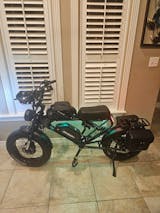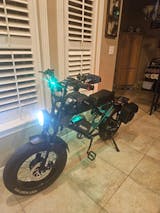Table of Contents
- 1. Basic Concepts of Speed and Range
- Key factors when considering motor size should include:
- 2. Tools and Methods for Speed Tests
- Mobile and Built-In Consoles
- Short Sprint Data Collection
- Speed Graph Analysis
- 3. Tools and Methods for Range Tests
- Tracking Real-World Range Estimates
- Monitoring Battery Logs
- Battery Capacity:
- Motor Heating Prevention:
- Energy-Efficient Practices:
- Performance Trends:
- Adjustments and Upgrades:
- 4. Key Factors Affecting Speed and Range
Riders seeking to optimize performance while remaining safe on challenging trails must carefully measure speed and distance using fast off-road e-bikes in order to monitor speed and range measurements on fast off-road electric bicycles. Understanding your range performance e-bike data enables more effective battery planning, enabling longer rides without unexpected power losses. Tracking these metrics ensures your e-bike meets the rigorous demands of off-road adventures. Utilizing tools designed to track e-bike acceleration insights can provide valuable information on how your bike reacts in different terrains and riding styles. Tools such as GPS apps and built-in consoles offer precise data, helping you make informed decisions regarding upgrades and maintenance for your bike. By monitoring performance metrics regularly, you can enhance your riding experience, extend its lifespan, and fully enjoy European trails' rugged landscapes.
1. Basic Concepts of Speed and Range
Acknowledging your electric bike's top speed data is critical in evaluating its performance. Top speed refers to the maximum velocity it can reach under ideal conditions and allows riders to set realistic expectations and plan rides efficiently.
Motor size plays an enormous part in range tests, for instance in a 750W e-bike speed test which compares different motor powers' effects on both speed and battery life. Larger motors like those from 750W provide more power, enabling faster speeds over tough terrains as well as quicker battery drain, but can drain quicker, thus shortening range considerably.
Key factors when considering motor size should include:
Power Output:
High wattage motors offer increased speeds and climbing ability, as well as better speed performance overall.
Battery Capacity:
An adequate battery can offset increased power usage caused by high wattage motors.
Riding Style:
Aggressive riding that involves frequent acceleration and high speeds will have more of an effect on range than steady, moderate riding.
All-terrain tire grip plays a pivotal role in maintaining balance on uneven surfaces. Excellent tire traction ensures your e-bike can handle challenging trails without losing control or sliding out, something especially critical for fast off-road e-bikes navigating challenging landscapes. Indicators that influence tire grip include:
Tire Tread Patterns:
Deeper treads offer better traction on loose or slippery surfaces, while properly inflated tires increase grip while decreasing punctures risk.
Tire Pressure:
Properly inflated tires improve grip while decreasing punctures risk.
Tire Material:
Durable materials provide higher performance in harsher conditions and may help extend tire longevity.
By understanding these key principles, riders can make informed decisions to optimize speed and range, providing an enjoyable off-road riding experience.
2. Tools and Methods for Speed Tests
To accurately gauge your 750W e-bike's speed performance, reliable tools and effective techniques must be employed for speed tests. Here are the essential ones needed to guarantee optimal peak performance capabilities:
Mobile and Built-In Consoles
GPS Apps:
Utilize apps like Strava or Komoot to accurately record e-bike speed test data. These apps track real-time speeds, distances and routes allowing for comprehensive insights into your bike's performance.
Built-In Consoles:
Many high-performance e-bikes feature integrated consoles that display top speed electric bike metrics. This instantaneous feedback on speed, battery usage and motor output helps monitor the range performance e-bike more effectively.
Short Sprint Data Collection
Conducting short sprints allows you to gain insights into e-bike acceleration. Simply ride at maximum speed for short periods until it reaches its peak power output and observe.
Measure Your Braking Distance After Sprints: Measure the optimal braking distance after each sprint to ensure that your e-bike can safely reduce speed from high velocities, something essential for off-road e-bike control.
Speed Graph Analysis
Consistency Check:
Analyzing speed graphs to assess your e-bike's performance can provide valuable insight. Look out for any steadily rising or falling patterns or sudden shifts that could indicate issues with its motor or battery.
Track Your Speed Trends Over Multiple Rides:
Tracing your speed over several rides helps identify trends and improvements, providing valuable data about motor efficiency and upgrades that may be necessary. Use this data to inform decisions regarding motor efficiency upgrades as needed.
Utilizing these tools and methods, you can accurately measure and increase the speed and range of your high-performance e-bike. Regular testing ensures it remains reliable and efficient - whether tackling rugged European trails or off-road adventures near you.
3. Tools and Methods for Range Tests
Testing an e-bike's range performance requires several reliable tools and effective methods in order toproduce accurate results. Here's how you should approach it:
Tracking Real-World Range Estimates
GPS Apps:
Use apps such as Strava or Komoot to monitor your real-world range estimates and gain detailed data on distance traveled and energy consumption.
Built-In Consoles:
Many high-powered e-bikes feature built-in consoles to display real-time range performance and battery usage information.
Varying Riding Conditions: Place your e-bike through different riding conditions such as uphill, downhill and flat terrain to assess how they affect its long distance range.
Monitoring Battery Logs
Battery Capacity:
Be sure to regularly monitor the capacity of your battery with either console or mobile apps to make sure it's performing optimally.
Motor Heating Prevention:
Monitor motor heating prevention by avoiding excessive speeds and providing proper cooling during long rides.
Energy-Efficient Practices:
Adopt energy-efficient motor designs and riding techniques in order to increase battery life and range performance, as well as repeat tests several times for accuracy and detect any anomalies.
Don't Forget Accuracy and Consistency Testing!: To gather accurate and consistent range test data and identify any discrepancies quickly.
Performance Trends:
Utilize performance e-bike analytics to monitor any improvements or declines in range over time.
Adjustments and Upgrades:
Apply data collected during analyses to make informed decisions regarding battery upgrades or motor efficiency upgrades.
By tracking and analyzing these metrics, you can optimize the range performance of your e-bike to ensure it remains reliable and efficient for off-road adventures.
4. Key Factors Affecting Speed and Range
Many elements impact the speed and range of an e-bike, such as battery age and capacity, that affect its performance. Understanding these influences is vital for optimizing your riding experience.
Battery Age and Capacity:
As your battery ages, its ability to hold a charge decreases, decreasing both speed and range.
Capacity:
Higher capacity batteries offer longer distance e-bike range. Always review its capacity before riding to make sure it suits your riding needs.
Terrain/Slope Challenges
Terrain Type:
Riding on uneven or rough terrain requires more power, impacting the performance of fast off-road e-bikes.
Slope Gradients:
Steep hills require additional motor effort that may reduce range; select an e-bike with appropriate motor size for challenging hills.
Wind Resistance, Posture and Weight Distribution:
Wind Resistance: Riding into strong winds can impede your speed performance, so maintaining an aerodynamic posture is vital in mitigating this effect. Maintaining an ideal riding posture reduces drag and increases speed performance.
Weight Distribution: Balancing weight distribution can improve all-terrain tire grip and stability for faster speeds and longer rides.
By considering these key elements, you can better manage the performance metrics of your e-bike. Monitoring battery capacity, adapting to different terrains and maintaining proper posture are all ways you can ensure you make the most of your high-performing e-bike.
5. European Focus and Local Variations
The European market for eco-friendly electric bicycles is expanding quickly due to increased environmental awareness and demand for sustainable transport solutions.
Environmental Awareness:
With environmental concerns rising in Europe, more Europeans are opting for eco-friendly electric bicycles to lower their carbon footprint and ease traffic congestion and emissions.
Urban Mobility:
Cities across Europe have begun promoting e-bikes as an efficient means of urban commuting - offering relief to traffic jams while simultaneously cutting emissions.
Government Incentives:
Many European countries provide government incentives and subsidies to encourage the purchase of electric bicycles.
Peak Performance E-Bike Deals Europe Can Provide Budget Planning Solutions:
Cost Efficiency:
Finding peak performance e-bike deals Europe helps riders invest in high-quality bikes without overspending.
Seasonal Discounts:
Take advantage of off-peak sales to secure the lowest possible prices.
Comparison Shopping:
For maximum value within your budget, compare offers from different European e-bike brands.
Local Shops Offering Upgrades or Repairs
Specialized Services:
In Europe, local e-bike shops provide essential services such as motor efficiency upgrades and battery maintenance to ensure optimal operation of their bikes.
Expert Advice:
Experienced staff can recommend the ideal accessories and performance upgrades to customize your e-bike for optimal off-road experiences.
Convenient Locations:
Nearby shops provide quick and reliable repairs, keeping your ride in great shape for off-road adventure.
By understanding regional variances, European e-bike enthusiasts can make informed decisions, maximize their investment and experience a seamless riding experience across various terrains.
6. Conclusion
To summarize, the key performance metrics for your high-performance e-bike include speed, distance and battery status. Monitoring this data enables you to gain an in-depth knowledge of its capabilities while making informed decisions for improvements down the line. Keep track of both speed and range to identify trends or areas for improvement, refine testing methods using advanced e-bike performance analytics and maintain bike safety with regular maintenance checks. This approach will enable you to optimize the efficiency of your range performance e-bike, enriching your riding experience and guaranteeing its reliability throughout all your European off-road excursions. Be proactive in keeping track of these metrics in order to enjoy each ride to its fullest.
7. FAQ's:
1) How Can I Precisely Assess My E-Bike Speed?
In order to accurately test the speed of your e-bike, use either a GPS-enabled app such as Strava or its built-in console. Choose a flat path with consistent pedaling effort, record multiple runs at top speed electric bike data collection, average the results and average them out for accuracy.
2) What Factors Affect an Electric Bike's Range?
Numerous elements can impact your e-bike's range, including battery capacity, motor efficiency, terrain type, rider weight and riding conditions. Furthermore, keeping an appropriate tire pressure setting and adopting an effective riding posture can extend its long distance range.
3) Which tools are ideal for tracking e-bike performance?
The top tools for monitoring and improving e-bike performance include GPS apps like Strava, built-in consoles on your e-bike, and cycling computers. These tools provide speed, distance, battery usage data which enables you to effectively monitor and improve range performance e-bike metrics.
4) Can I Increase Battery Life on My E-Bike?
To increase battery life on your e-bike, avoid fully depleting its capacity and charging it regularly. In addition, ride at moderate speeds with proper tire pressure while using energy efficient motor designs and store the battery in a cool and dry location to prolong its lifespan.




















